The goal kick has remained in a constant flux of evolution since the rule change introduced in 2019 that mandated the ball no longer having to leave the penalty box before being touched by another player.
Many teams insist on playing out even under intense pressure from the opposition, and their set-ups and patterns are ever-changing with the introduction of new pressing strategies.
Whether teams play long from goal kicks or short to draw teams high before exploiting the space behind them, the goal kick is now thought of as an opportunity to create goalscoring opportunities.
This tactical theory analyses how one team, Tottenham Hotspur, under Ange Postecoglou’s tactics, have been a goalscoring threat from their goal kicks.
Using tactical analysis, we analyse the Premier League side’s patterns of play from goal kicks and provide an analysis of the tactics opposition teams have tried to counteract them.
Goalkeeper Receiving
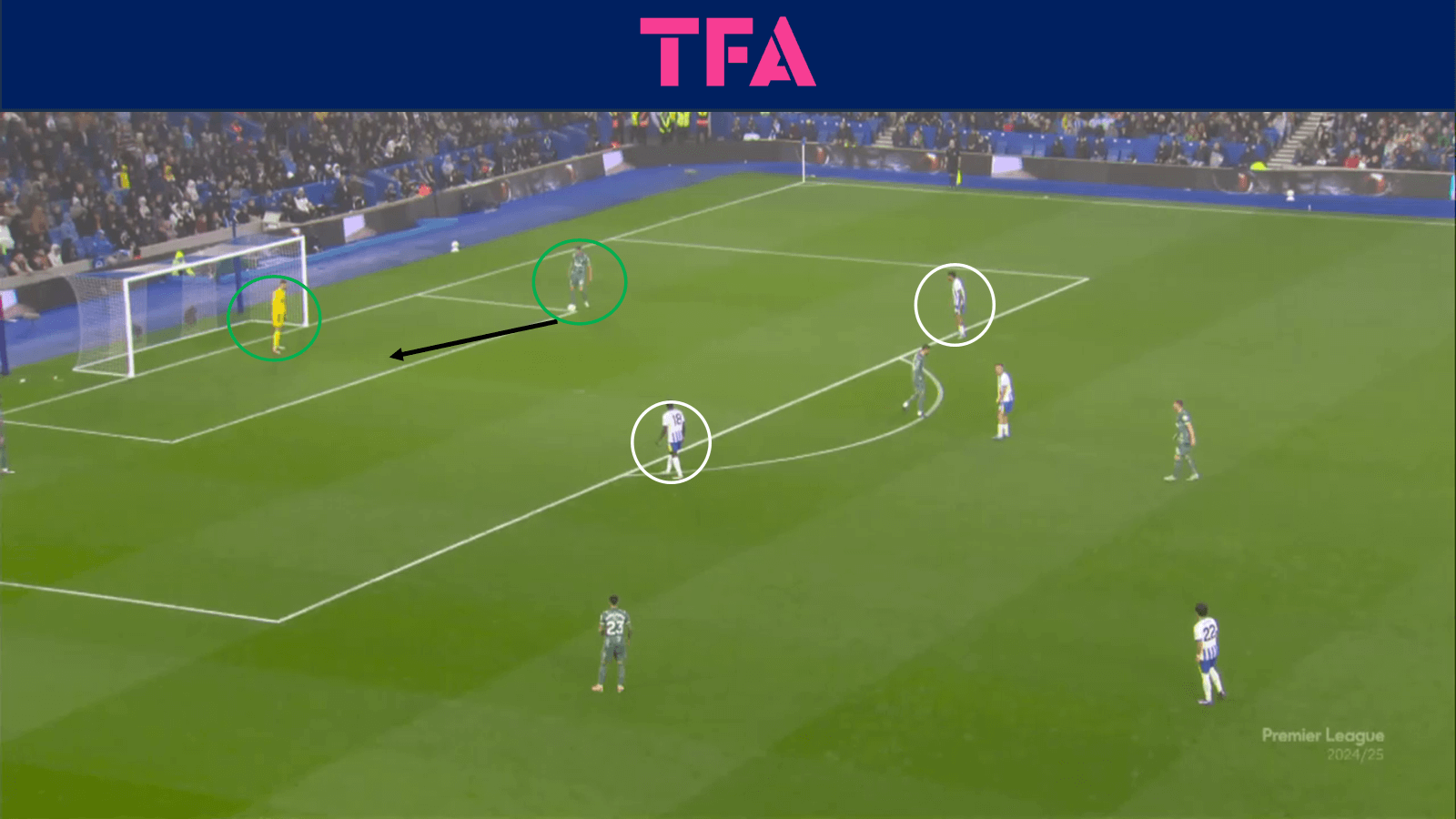
The image above is from Spurs’ recent defeat to Brighton, a game in which they were winning 2-0 thanks in part to a goal created from a goal kick.
In this match, under Ange Postecoglou’s coaching style, Spurs deployed the ever more common tactic of having a centre-back take the goal kick and pass to the goalkeeper.
Here, one centre-back is on the corner of the six-yard box with the ball, and the other is on the side of the six-yard box.
Two of Spurs’ midfield three are positioned in the same vertical line, leaving them space on either side to exploit.
The full-back is inverted to the width of the box.
This can create space for the winger in the wide area by allowing him to drop into the space vacated by the full-back.
Once the ball is rolling, the full-back moving wide and taking the opposition wide midfielder with him can also open up a passing lane for the winger in a more central position.
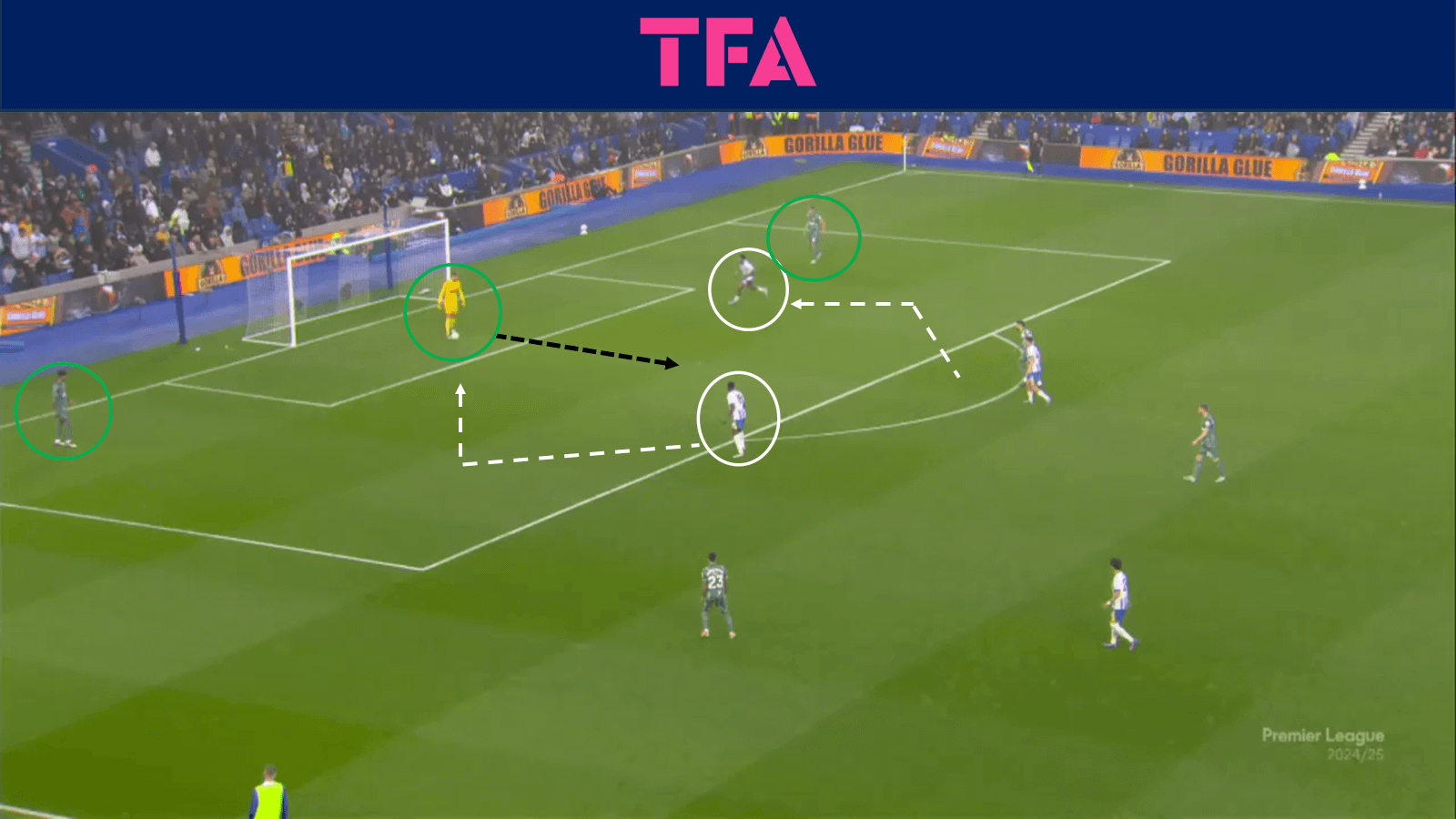
The goalkeeper is in a central position when receiving the first pass, so should the opposition press with two forwards, as shown here, it can be a more complicated position for the opposition to press.
As shown by the arrows, if the opposition tries to press from the outside to cut off the centre-backs, the goalkeeper has the opportunity to drive straight through the middle of them.
This action by the goalkeeper would then completely eliminate the front two from the game and open up the entire pitch.
Even if the goalkeeper then elects to play along, he’s doing it from a more advanced position, making his long kick more dangerous.
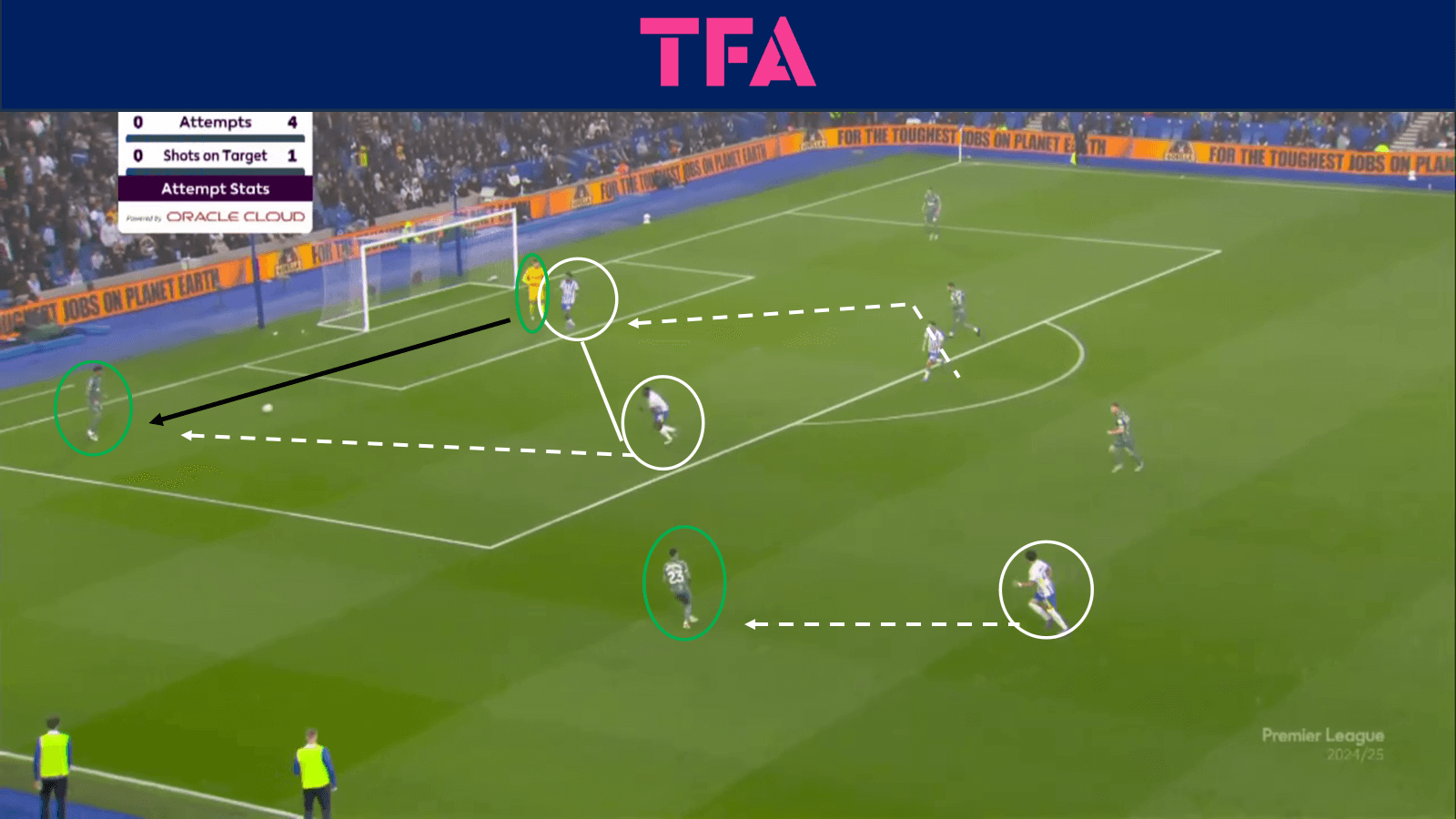
Brighton took a different approach to prevent the goalkeeper from being able to do this and try and trap Spurs down one side.
As the ball was played to the goalkeeper, one forward cut off the left-centre back, with the other forward remaining at the edge of the box and an attacking midfielder marking Spurs’ ‘6’.
The forwards’ movement created a diagonal line, and with their attacking midfielder marking Spurs ‘6’ tightly, it forced the goalkeeper to play a predictable pass to his right.
The pass to the right centre-back was the trigger for the ball near forward to begin to press.
Importantly, in this scenario, Brighton’s wide midfielder was in a position to press Spurs’ right-back immediately if he had been played the ball.
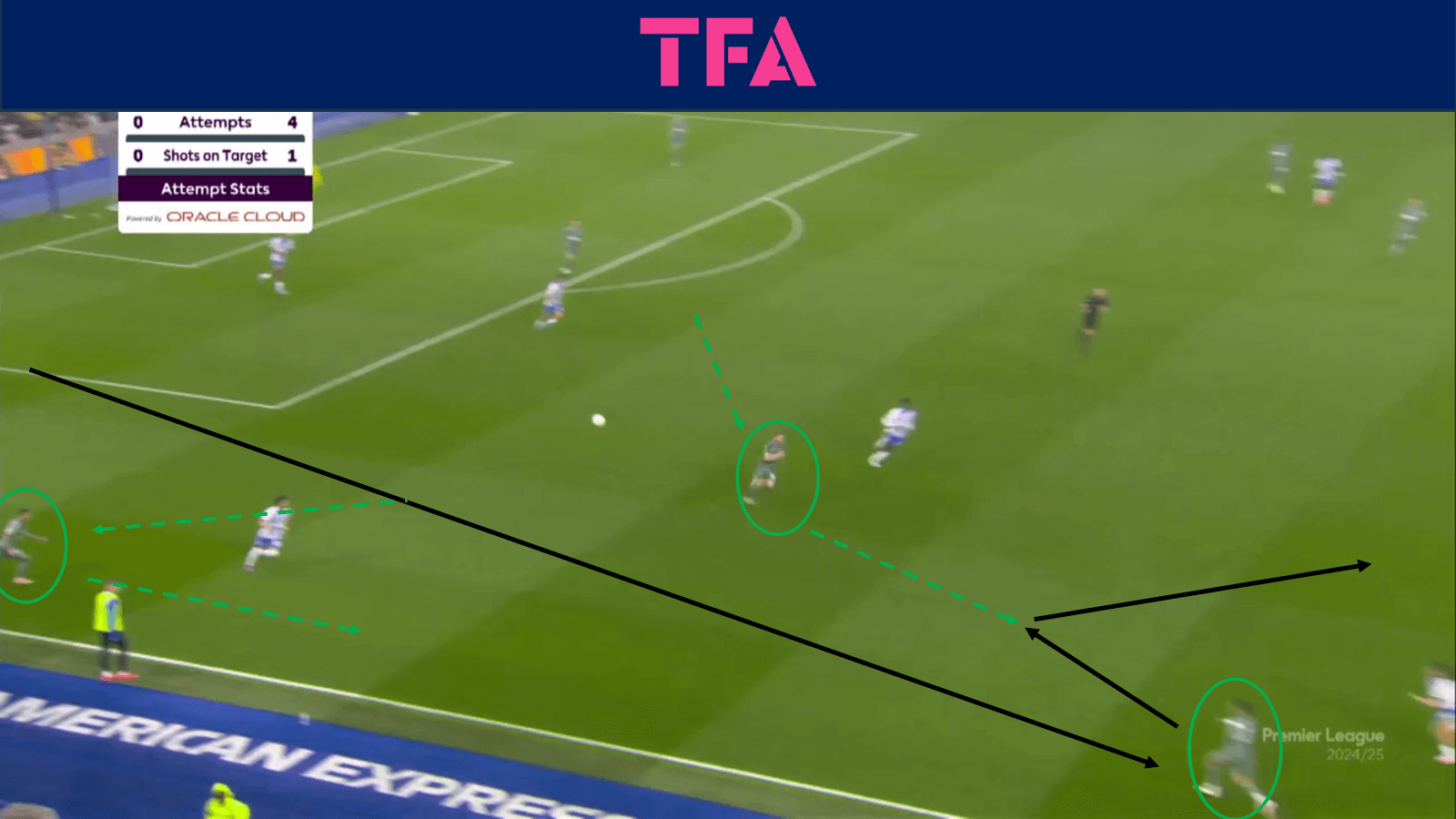
The wide midfielder forces the centre-back to play long into his winger in the wide area by being tight to the right back.
The right-back helped create the space for the winger to receive by dropping towards the ball, even though he was unlikely to receive it.
The winger receives the ball in the air, facing his own goal, with his right back and ‘6’ making supporting movements underneath him.
The timing of the supporting runs allows him to bounce the ball first time back to his ‘6’, instead of trying to control it under pressure.
The ‘6’ then plays into the striker, who switches the play to Spurs’ left winger.
This leads to an attack that reaches Brighton’s box and finishes with a blocked shot on goal.
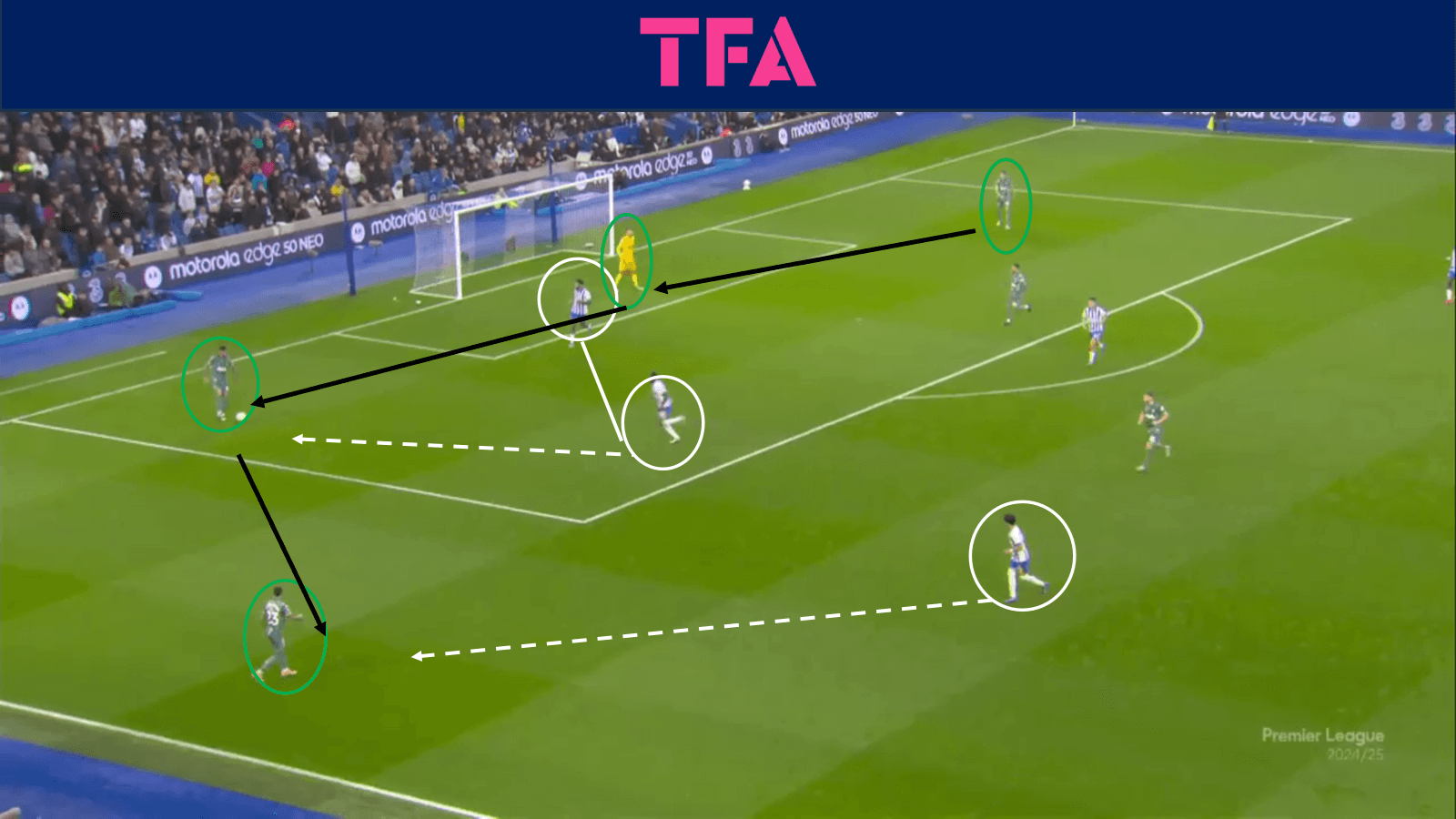
This goal kick and the subsequent pattern of play played out very similarly to the previous one.
The key difference here is the starting position of Spurs’ right-back
Instead of being inverted, he is positioned much wider in the wide area.
This gives him an extra 10 yards or more of space from the pressing wide midfielder of Brighton.
This extra space is afforded to him due to the Brighton midfielder prioritizing protecting the half-space channel.
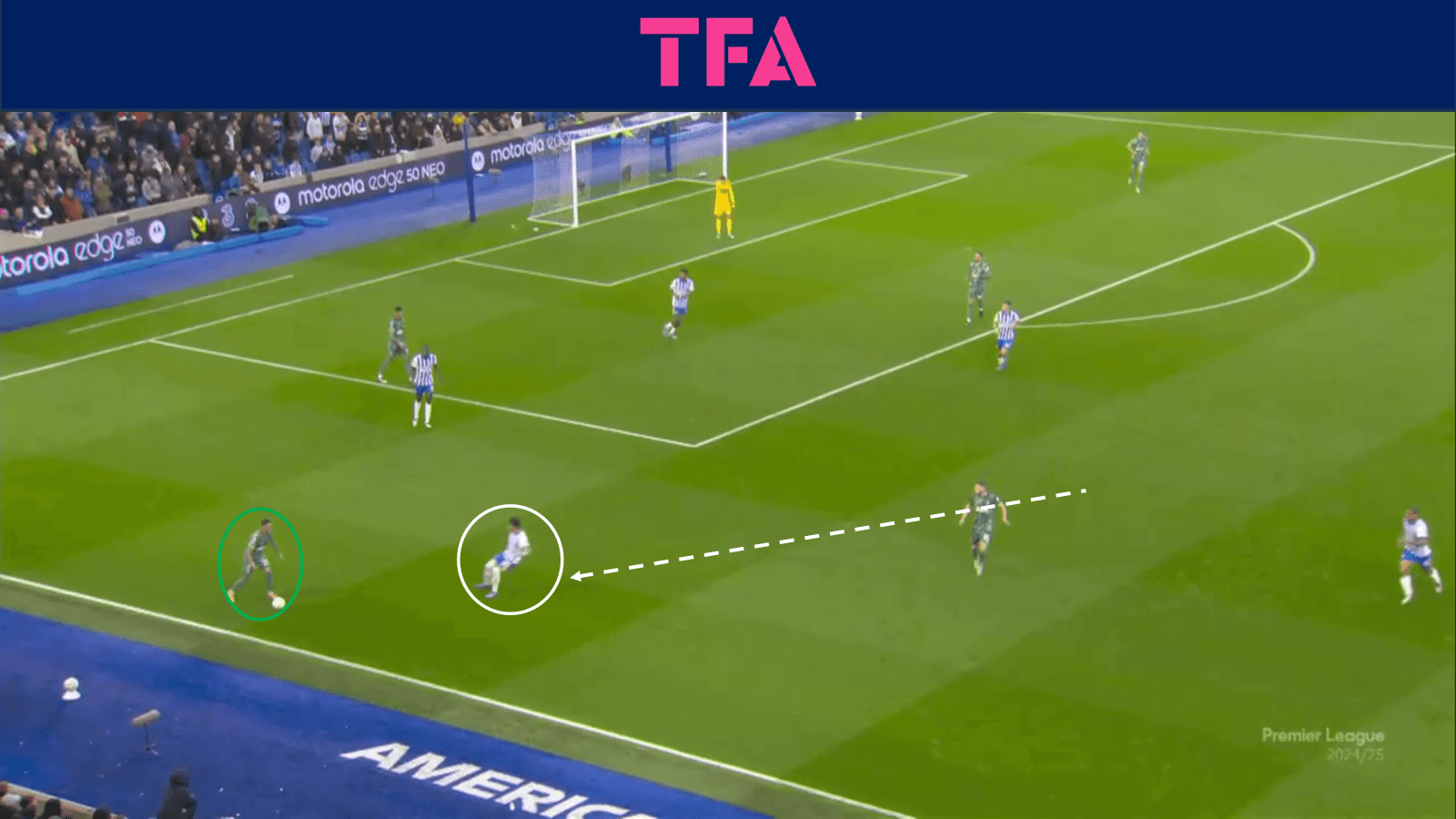
This distance allows the right back time to control the ball and lift his head to look down the pitch.
The right-back then plays a pass into his striker’s feet.
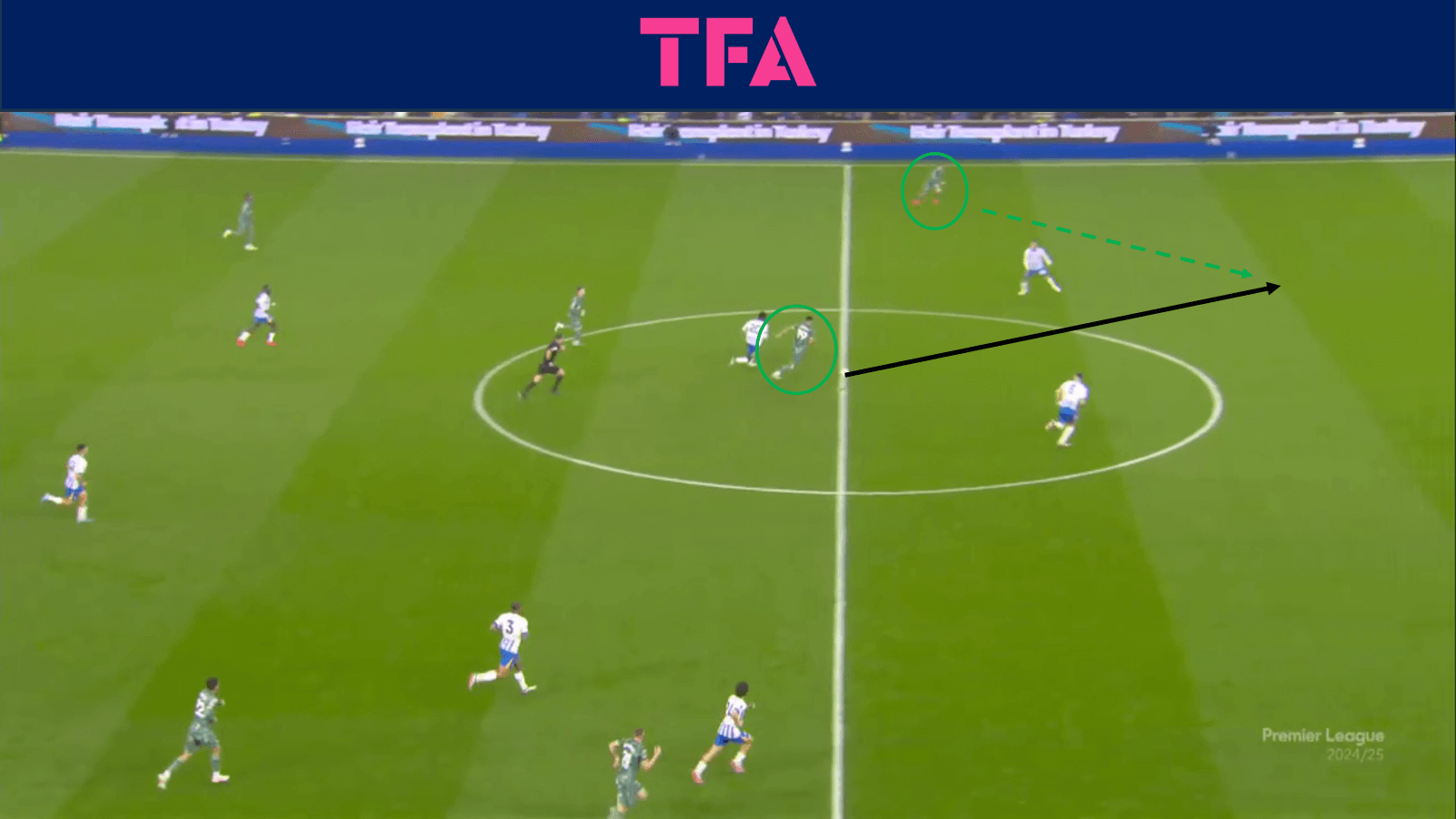
The outcome is similar, with the striker receiving the ball at his feet, but the ball got there far quicker due to the two fewer passes required by the right-back playing directly into him.
This difference in the speed of the attack made this situation much more dangerous.
Brighton is far more exposed in this scenario, with fewer defending players behind the ball.
The striker was able to turn and play the through ball to his winger; the play resulted in Spurs’ second goal of the match.
The speed of the play, especially when compared to the previous scenario, meant Brighton had fewer players to defend the box when it got there and fewer bodies to block the resulting shot.
Goalkeeper Receiving – Opponents Adaptation
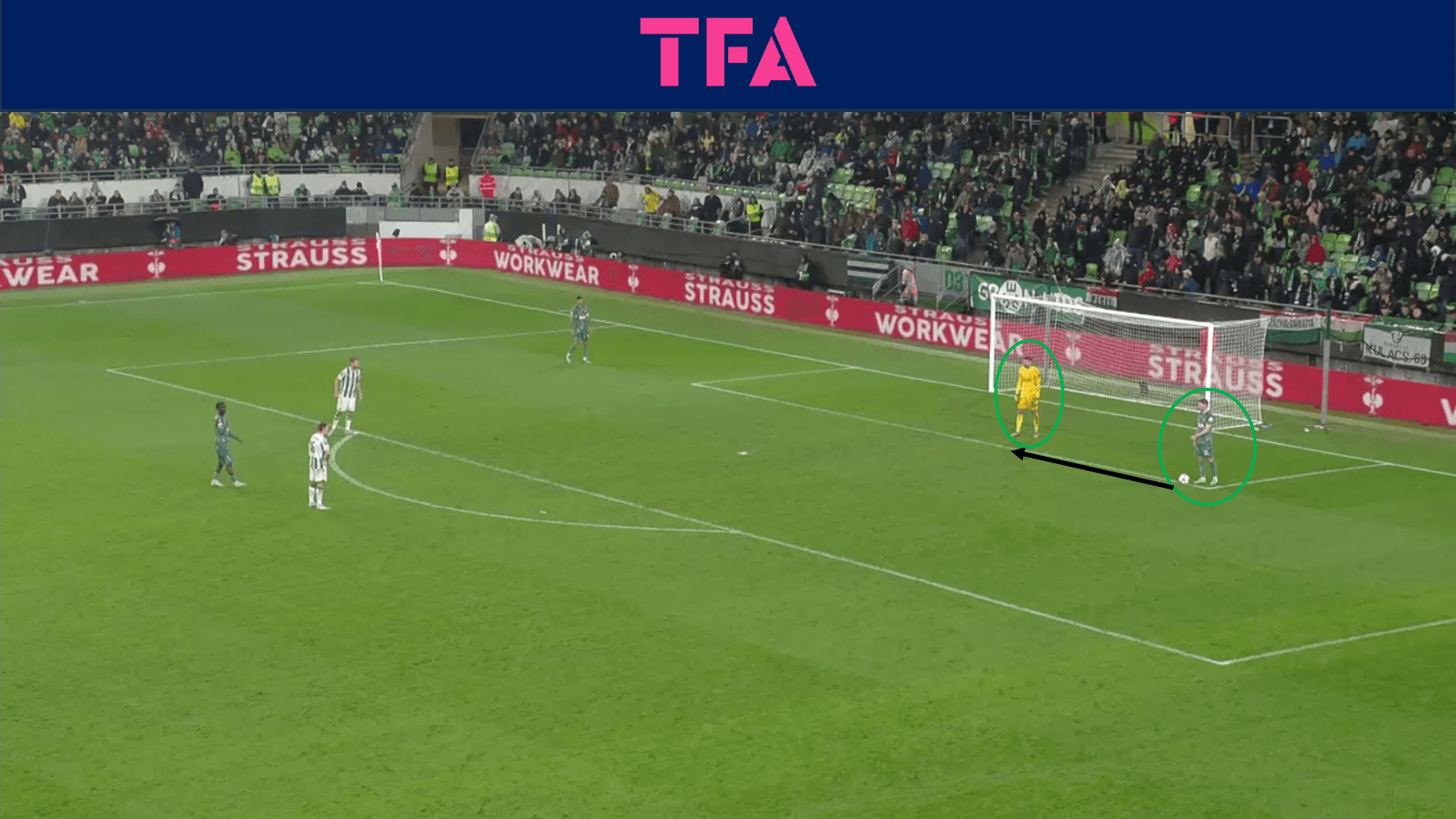
Spurs’ UEFA Europa League opponents Ferencvárosi tried a slightly different approach than Brighton to counter Tottenham’s goal kick set-up.
When the ball was passed, the Ferencvárosi ball-far forward sprinted at the goalkeeper’s right foot after a slightly looped run to force the goalkeeper to his left.
The ball-near forward, who is positioned relative to Spurs’ ‘6’, was primed to leave his mark and sprint at the left centre back, should he receive a return pass, whilst blocking off a pass into the ‘6’
The idea here was to trap the Spurs down their left side.
However, with the ball near the forward, who was positioned to cut off the six before pressing the centre-back, he was too central to affect the centre-back’s first touch.
To allow himself to take his first touch past the pressing forward, as soon as he passed to the goalkeeper, the centre-back sprinted into the space left by the two forwards.
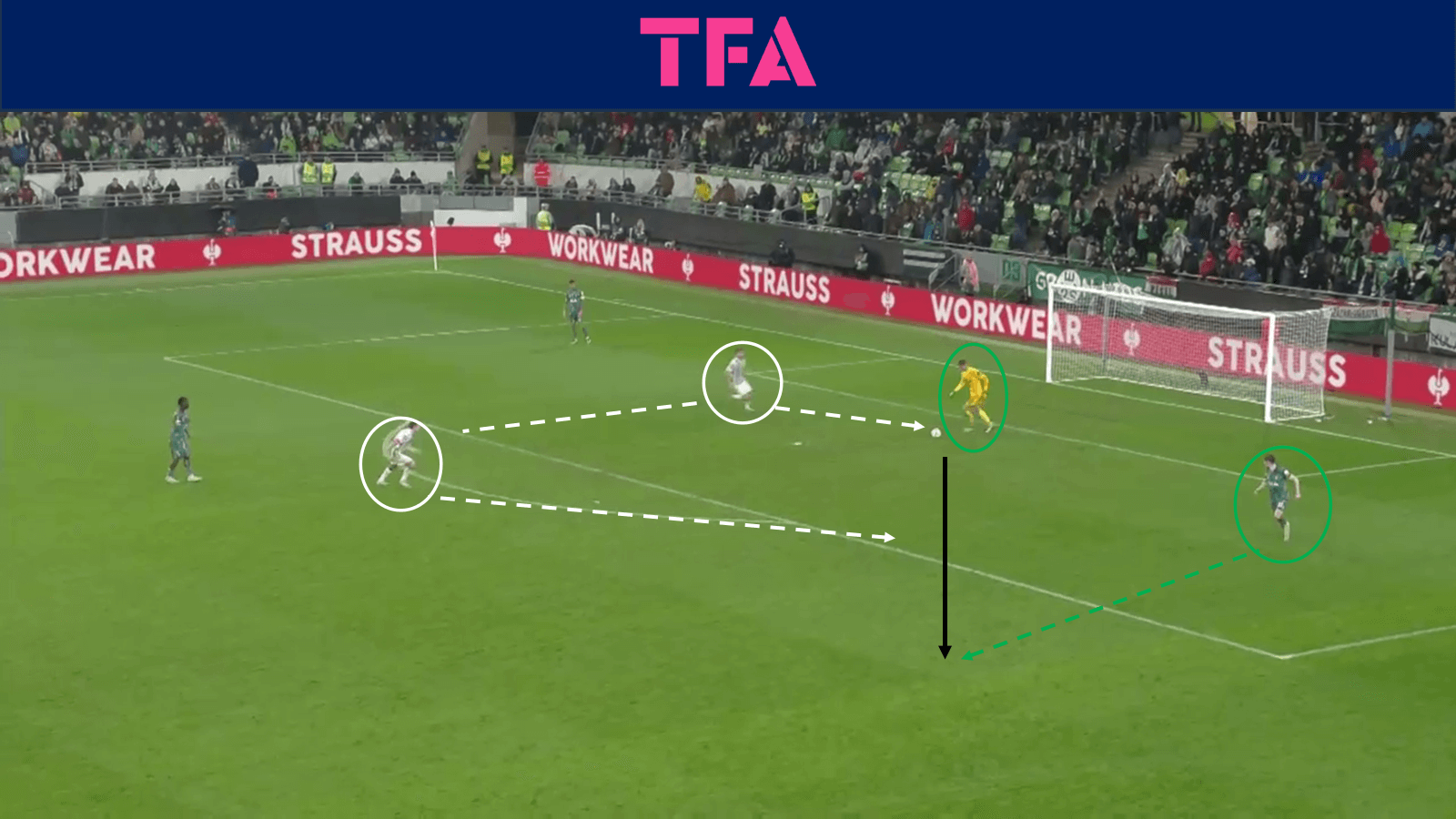
This allowed the centre-back to receive the next pass from the goalkeeper already past the first line of pressure.
With Spurs’ two central midfielders in high positions to create a gap between Ferencvárosi’s forwards and midfielders, the centre-back can take a comfortable first touch and raise his head to find the next pass.
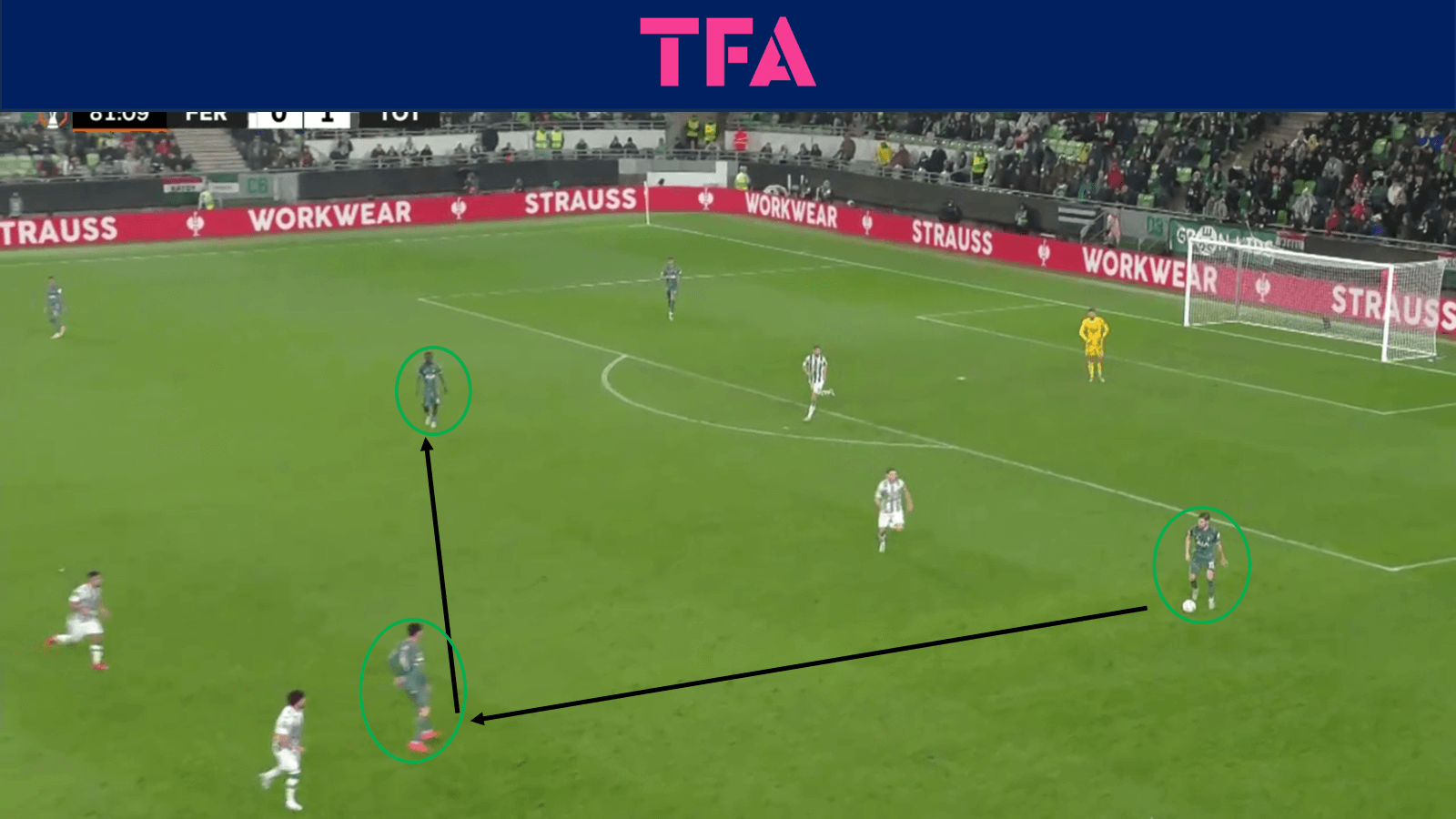
Another critical concept on show here is midfielders, or forwards, arriving from higher positions towards the ball.
This allows them to become wall players for the ball to bounce off to someone else.
The third player is typically in more space and is facing forward.
Here, Spurs use this bounce pass to play their ‘6’ in space and switch the point of attack.
This goal kick is yet another that results in a shot goal for Spurs.
The Bounce Pass
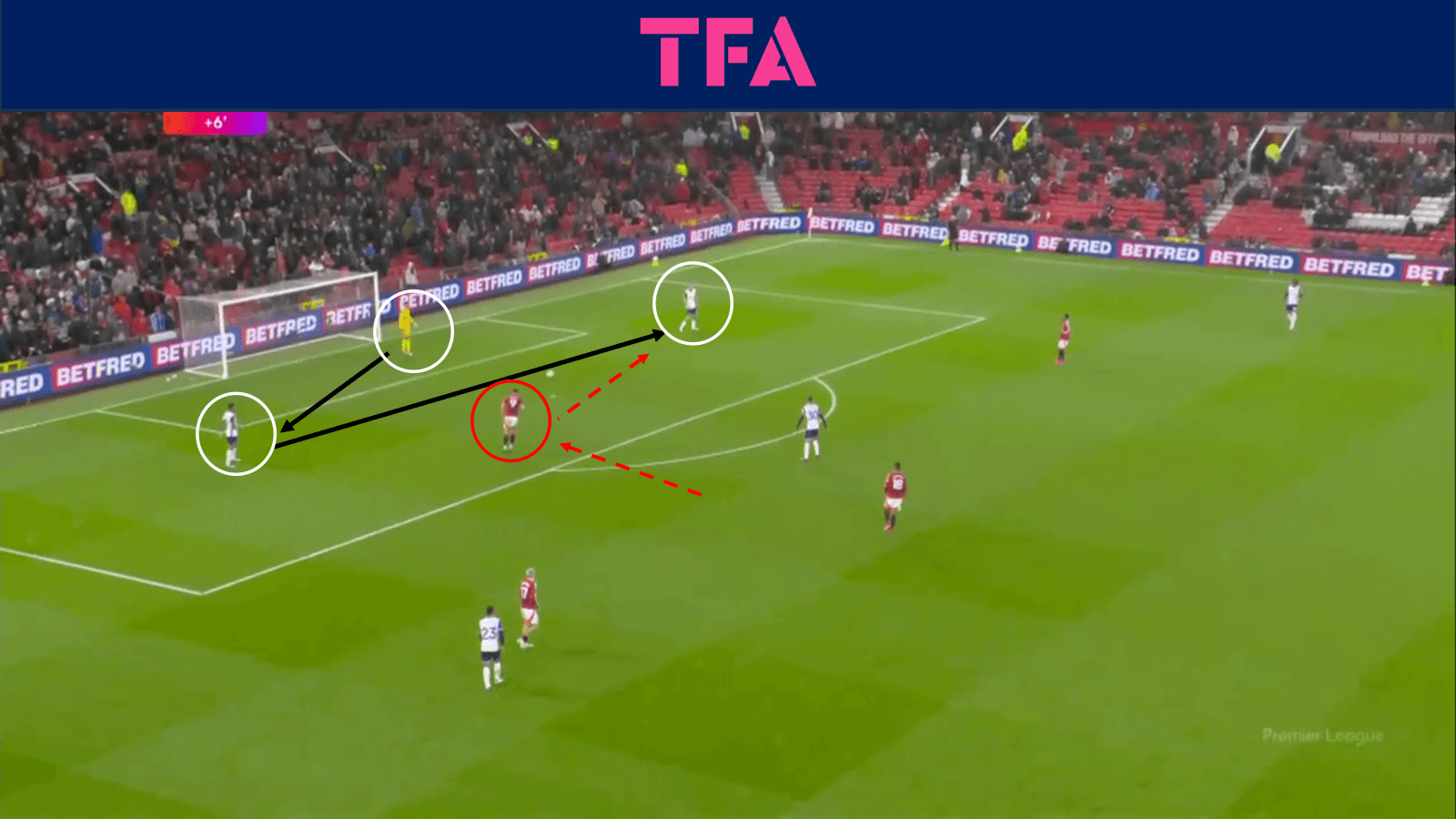
Spurs’ trait of using bounce passes to progress the ball during their build-up play was on display during their recent victorious trip to Old Trafford.
Here, Manchester United pressed them with one centre-forward.
Spurs’ goalkeeper took the kick this time and passed to his right-centre back.
As with the previous examples, the lone forward attempted to loop his pressing movement and act as a trigger for trapping Spurs down their right.
However, the centre-back played his pass first time to his defensive teammate before the striker could get anywhere near him.
The receiving player then had enough time to take a casual touch forward under no pressure.
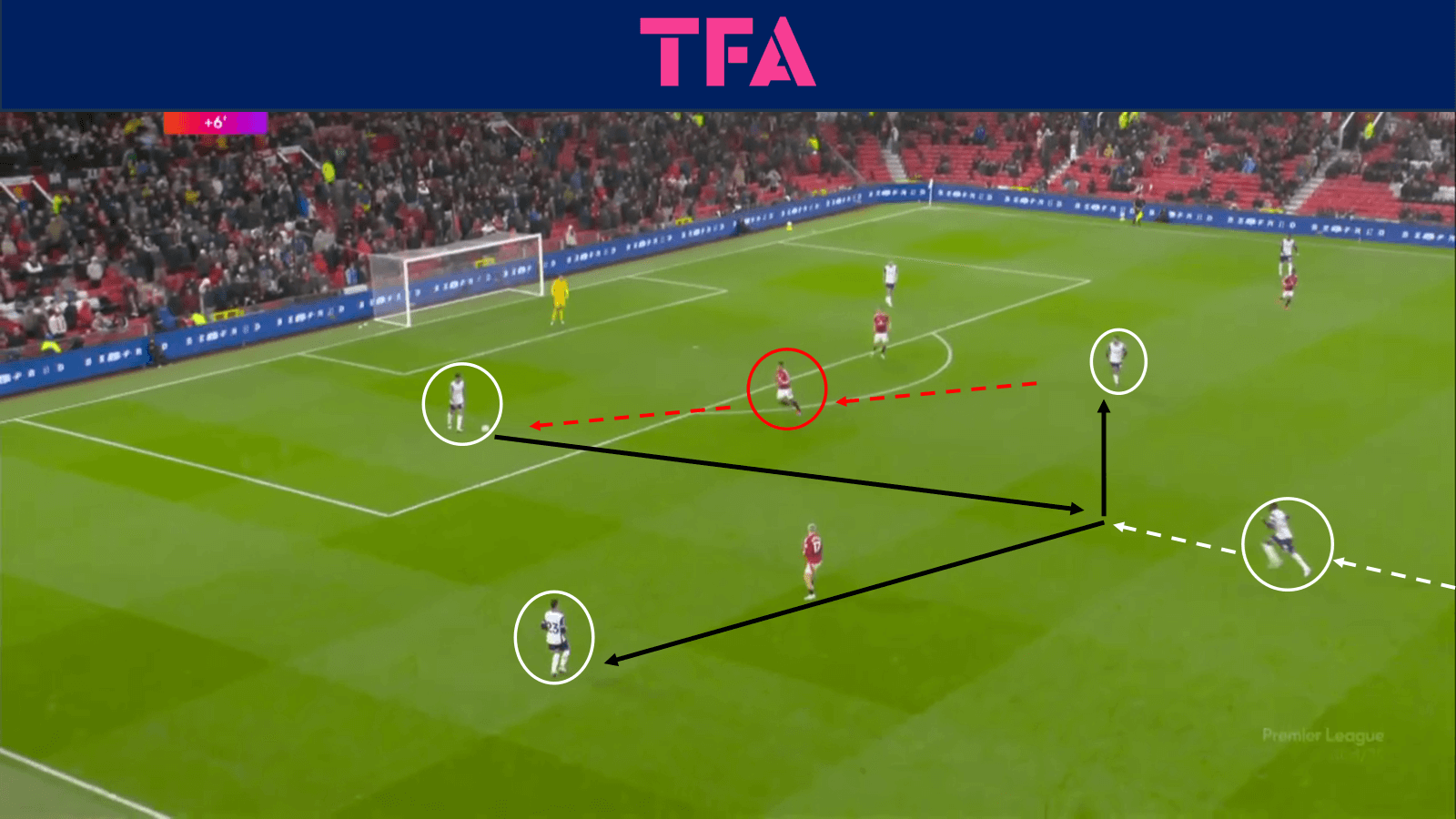
As the centre-back took his first touch, the ‘6’ ran away from the ball before making a sharp double movement back towards it.
With the opposition attacker tracking him on his blind side, receiving on the half-turn to play forward was risky.
This quick movement allowed him to receive relatively flat, facing his own goal, but able to clearly see and play a safe pass to his right centre-back.

Another common trend is repeated after the ball is switched to the centre-back.
A central midfielder arrives from a high position with his back to the goal.
His teammates support him underneath, allowing him to receive a first-time bounce pass.
The arriving midfielder has three clear options — play back to his centre-back, bounce to the ‘6’ or play into his right-back in the wide area.
Spurs’ ‘6’ finds himself in lots of space due to the Manchester United forward having jumped to press the centre-back.
Conclusion
The goal kick has evolved significantly to become one of the most important passages of play in the modern game.
Whilst it is not without its risks—many goals have been conceded this season alone by teams trying to play out—it has become a new mode of creating chances.
It is one of the few occasions in a match where teams can set up in exact, pre-planned positions with pre-planned patterns of play.
Through analysis, coaches can often reliably predict how the opposition will set up and react to their plays.
This means spending more time on the training ground practising these situations, and, as Spurs and many others have shown, it is now considered a way to score goals.

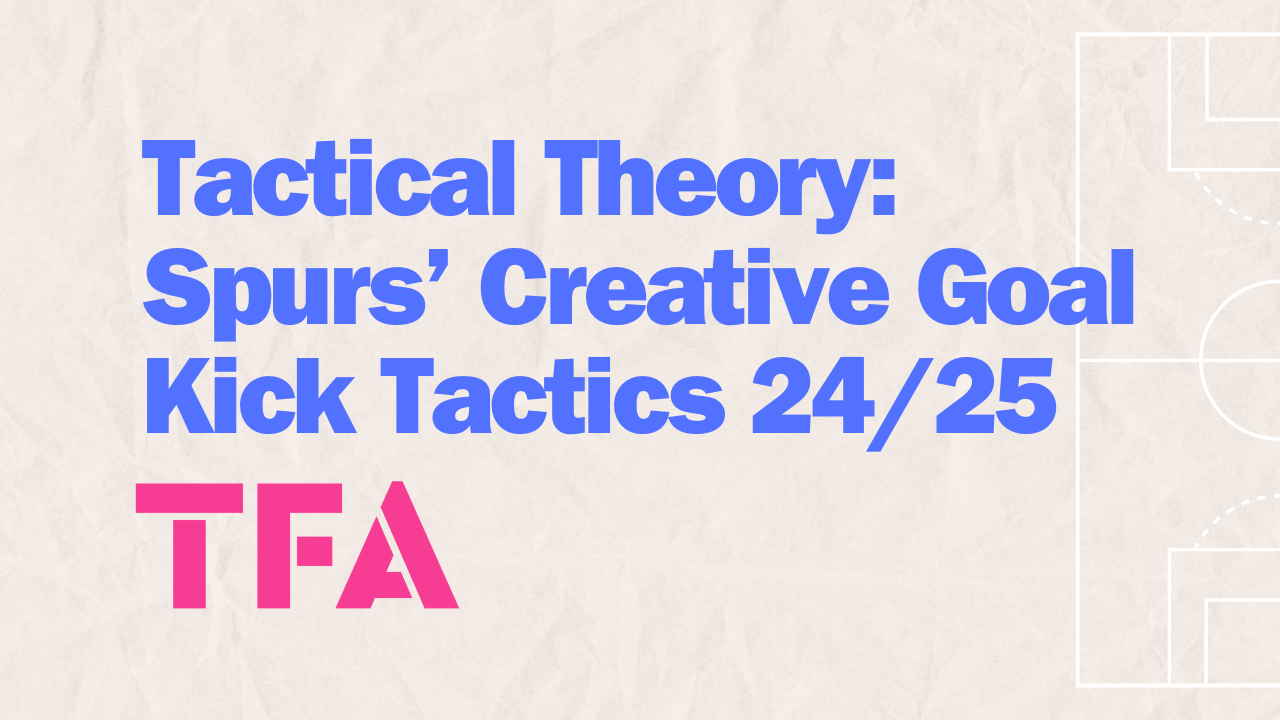




Comments